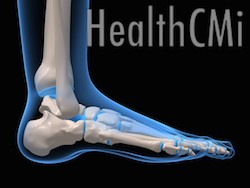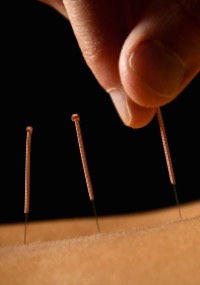Recent research indicates acupuncture is an effective and safe treatment for heel pain. Heel pain is a common foot condition often characterized by intense pain, especially when placing weight onto the foot. Pain on the back of the heel often indicates achilles tendinitis and pain on the underside of the heel often indicates plantar fasciitis. 
One of the most common causes of heel pain, plantar fasciitis involves pain and inflammation of the band of tissue running across the bottom of the foot. The new research indicates that acupuncture is effective for plantar fasciitis, achilles tendinitis and many other forms of heel pain. Treatments for heel pain are featured in the HealthCMi online acupuncture CEU and PDA course entitled Plantar Fasciitis.
Biomedical approaches to heel pain treatment include behavioral therapy, nonsteroidal antiinflammatory drugs (NSAIDs), corticosteroid injections, small needle knife therapy, block therapy, shockwave therapy and surgery. Traditional Chinese Medicine (TCM) historical records document success in the treatment of heel pain using acupuncture. This new scientific investigation confirms the historical data.
The researchers from Guangzhou Dongsheng Hospital and Guangzhou Social Welfare House examined 19 separate clinical investigations and discovered that 16 of the 19 studies made extensive use of ahshi acupuncture points to achieve optimal patient outcomes. In one investigation carried out by Xu Xuemeng et al., 66 patients were randomly divided into an acupuncture group and a control group. The acupuncture group received filiform acupuncture needle method treatment and the control group received triamcinolone acetonide acetate injections and local blocking therapy. The results were assessed six months following the treatment. The acupuncture group achieved an effective rate of 97% and the drug therapy group had a 76% effective rate.
Studies also indicate needling combined with moxibustion have a positive effect on patient outcomes. In one investigation carried out by He Yucai et al., 75 cases of heel pain were treated with acupoints Yongquan (KI1), Rangu (KI2), Taixi (KI3), Sanyinjiao (SP6), Chengshan (BL57) and ashi acupoints on the affected side. During the treatment, needles were quickly inserted perpendicularly using the lifting and thrusting method and mild reinforcing-reducing manipulation methods were applied. Needles were immediately withdrawn after a deqi sensation was achieved.
After needling, moxibustion was applied to ashi points on the heel. The moxibustion was applied for 10 minutes. Acupuncture and moxibustion were administered once per day for a period of six days, comprising one course. The second course started two days after the completion of the first. After two courses of treatment, the acupuncture group significantly outperformed the control group that was treated with ibuprofen sustained release capsules and the herbal formula Zhuanggu Guanjie Wan (Strengthening Bone and Joint Pills). Based on the 19 reviewed studies that were performed in the past five years, the researchers conclude that acupuncture is safer, easier to apply, and more effective than conventional treatments for heel pain. 
TCM Theory
The researchers give a historical account of TCM theory for the treatment of heel pain. In TCM theory, heel pain is often categorized as an illness of Numbness of Kidney or Numbness Syndrome. Heel pain often occurs in middle-aged or elderly people and is therefore in accordance with the TCM theory of “kidney governing bone.” A primary principle of acupuncture treatment is tonifying kidney Qi, warming the Du Channel and invigorating collaterals to unblock numbness and stop pain. To emphasize the importance of tonifying kidney Qi and Yin, acupuncture is mostly applied to the acupoints on kidney and bladder channels plus ashi points. To learn more about heel pain including plantar fasciitis, visit the HealthCMi webpage featuring the acupuncture continuing education CEU course entitled Plantar Fascitis.
Reference:
Tang, Cuanqi, et al. “Progress of Clinical Research on Acupuncture and Moxibustion for Heel Pain.” World Chinese Medicine 9.1 (2014): 120-123.


